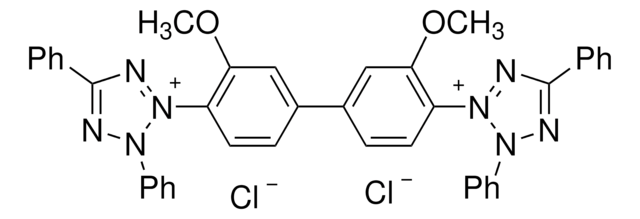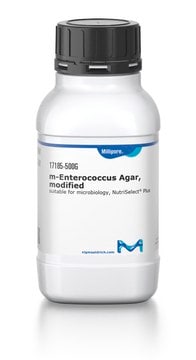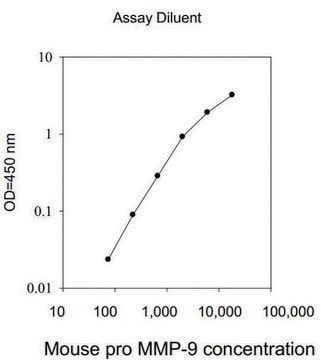17779
2,3,5-Triphenyl-tetrazolium chloride solution
suitable for microbiology, Filter sterilized solution that is recommended for the detection of microbial growth based on reduction of TTC
Sinonimo/i:
TTC solution, TTC supplement, TTC solution, TTC supplement
About This Item
Livello qualitativo
Sterilità
sterile (Filtered and Aseptic Handled)
Forma fisica
liquid
Durata
limited shelf life, expiry date on the label
PM
334.8 g/mol
applicazioni
agriculture
environmental
food and beverages
microbiology
Temperatura di conservazione
2-8°C
Compatibilità
bacteria
Stringa SMILE
[Cl-].c1ccc(cc1)-c2nn(-c3ccccc3)[n+](n2)-c4ccccc4
InChI
1S/C19H15N4.ClH/c1-4-10-16(11-5-1)19-20-22(17-12-6-2-7-13-17)23(21-19)18-14-8-3-9-15-18;/h1-15H;1H/q+1;/p-1
PKDBCJSWQUOKDO-UHFFFAOYSA-M
Categorie correlate
Descrizione generale
Applicazioni
Componenti
2,3,5-Triphenyl tetrazolium chloride: 0.1 g, distilled water: 10 ml
Codice della classe di stoccaggio
10 - Combustible liquids
Classe di pericolosità dell'acqua (WGK)
WGK 2
Punto d’infiammabilità (°F)
Not applicable
Punto d’infiammabilità (°C)
Not applicable
Dispositivi di protezione individuale
Eyeshields, Gloves
Choose from one of the most recent versions:
Possiedi già questo prodotto?
I documenti relativi ai prodotti acquistati recentemente sono disponibili nell’Archivio dei documenti.
I clienti hanno visto anche
Articoli
Vibrio Detection
Il team dei nostri ricercatori vanta grande esperienza in tutte le aree della ricerca quali Life Science, scienza dei materiali, sintesi chimica, cromatografia, discipline analitiche, ecc..
Contatta l'Assistenza Tecnica.

